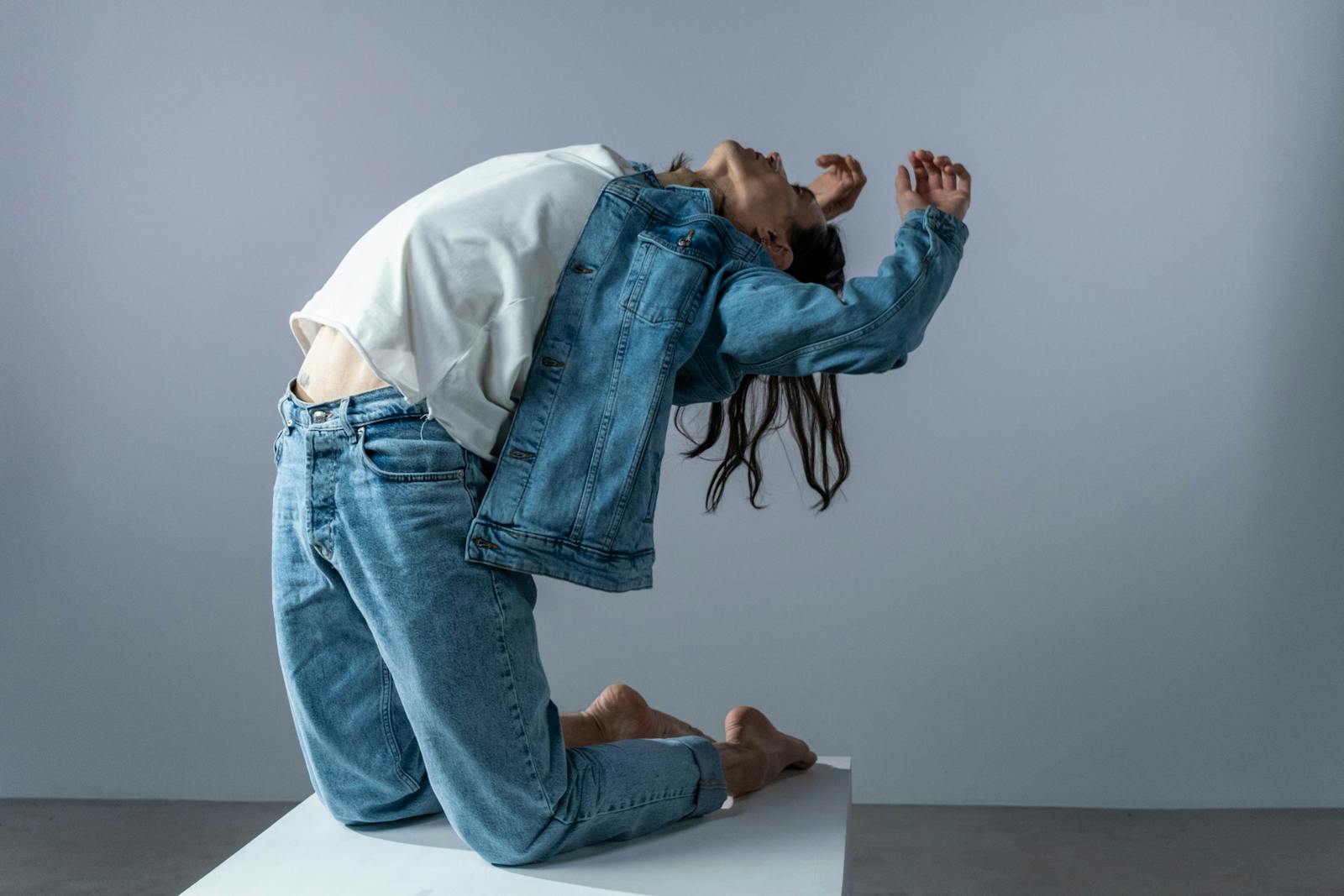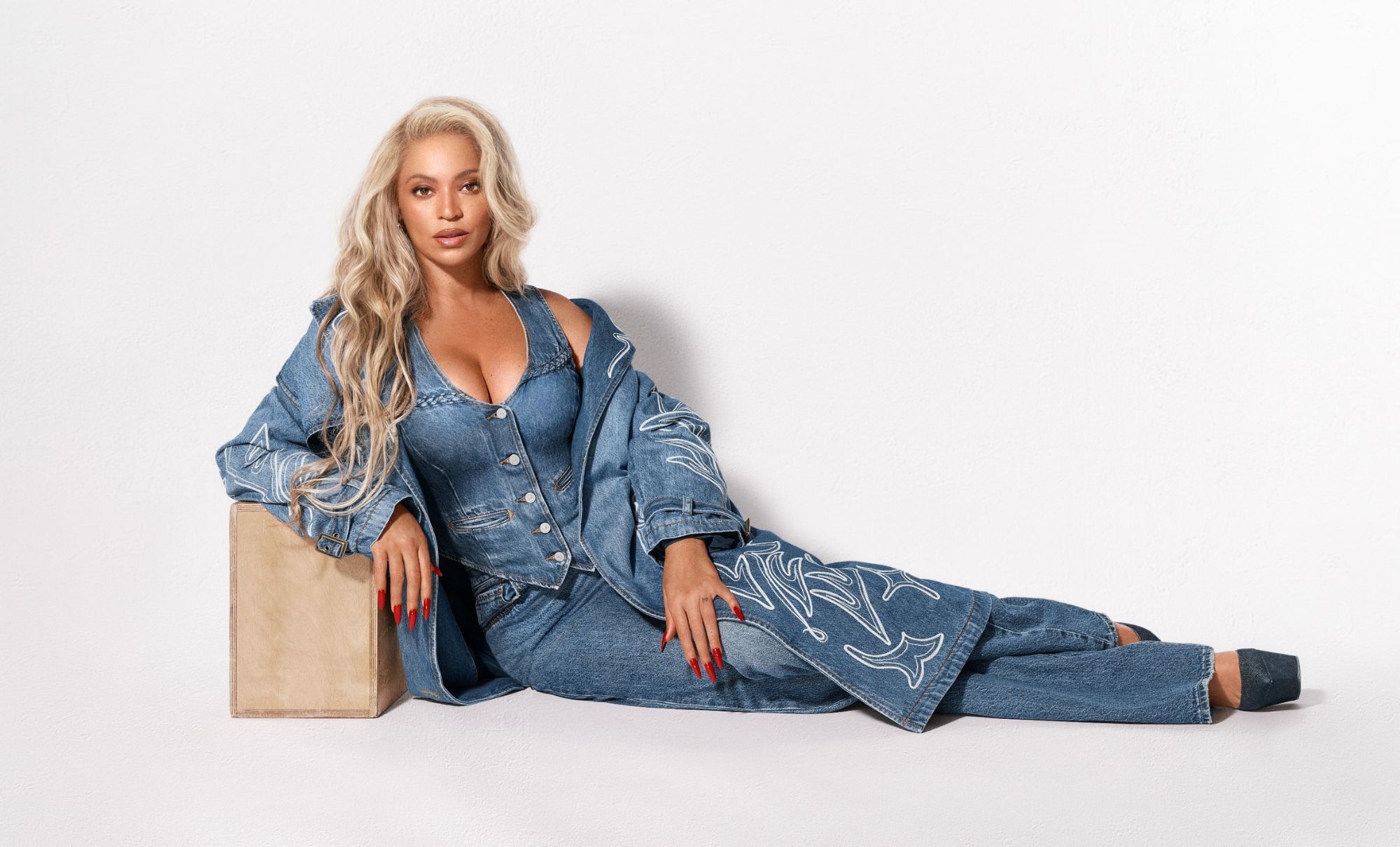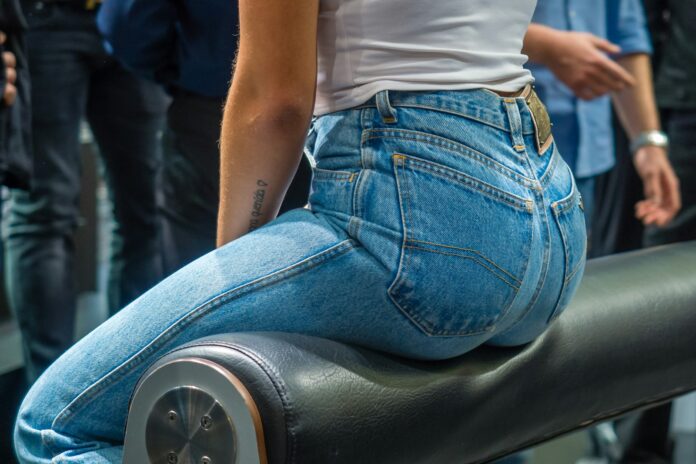The denim look is not simply a garment. It is a cultural obsession that refuses extinction. Worn by miners, rebels, aristocrats, artists, club kids and runway aristocracy, it has been buried countless times only to reappear with sharper edges. Every return of the denim look is a resurrection of desire. It is both democratic and elitist, vulgar and sublime, a uniform for those who dream of rebellion while craving beauty.
To wear the denim look is to carry myth on your skin. In the 1950s, James Dean turned it into cinematic iconography, a fabric of rebellion wrapped around American cool. In the 1970s, it burned under disco lights, stitched into hedonism and freedom.
In the 1990s, it reappeared with grunge austerity and minimalist power, jeans paired with white tank tops and attitude. Today, the denim look is returning with renewed seduction. It no longer hides behind nostalgia. It arrives as cultural armour for a generation fatigued by synthetic surfaces and yearning for fabrics that breathe history.

Denim is more than fabric. It is a biography. Every fold and fade maps movement and memory. The denim look is now being sculpted by designers who understand that obsession itself can be tailored. Acne Studios cuts indigo like architecture, B Sides dismantles vintage fragments to create artisanal bricolage, and Khaite transforms denim into minimalist erotica. Together they prove that the denim look is not back because it was gone. It is back because fashion cannot live without it.
This article explores the mythology of denim through cinema, history and runway. It examines why the denim look has returned now with such intensity and which designers are reshaping its codes. Prepare for a journey that is part seduction, part scholarship and entirely fashion.
Denim is Myth Woven in Blue
Denim is not a fabric. Denim is cinema, rebellion and memory stitched together in blue. When James Dean leaned against a wall in Rebel Without a Cause in 1955, denim was not trousers. It was masculinity in crisis, a scream against the bland conformity of Eisenhower America. When Jane Birkin strolled through Paris in flared denim, she was not dressing. She was liberating the female body from the constraints of couture. The denim look belongs to cinema because cinema belongs to myth.
Denim absorbs cultural power and amplifies it. Brooke Shields whispering that nothing comes between her and her Calvin Klein jeans in 1980 was not an ad. It was the birth of denim as erotic provocation. Madonna’s knotting of denim into a pop spectacle in the 1980s proved that fabric could be scandalous. Kate Moss in the 1990s, wearing denim with little else, made it nihilistic chic. The denim look insists that clothes are never neutral. They are theatre.
From Workwear to Subversion
Levi Strauss never imagined this when he cut his first trousers for miners. Denim was supposed to be practical, not mythical. Yet what fascinates is precisely the metamorphosis. In postwar Europe, denim was contraband, smuggled and worn by young people desperate to break from austerity. In the Soviet Union, denim was rarer than cash. It became a secret symbol of freedom, a parallel currency of Western glamour. The denim look has always been a rebellion disguised as a uniform.
The Semiotics of the Denim Look
Roland Barthes hinted that clothing is a language. If so, denim is the dialect of resistance: Dick Hebdige, writing about punk subculture, called style a form of refusal. The denim look embodies that perfectly. It is paradoxical. It is the same for everyone, yet altered by everybody. Ripped, washed, frayed, patched, it transforms uniformity into biography. It resists luxury by infiltrating couture, resists order by becoming the ultimate order of streetwear.
On the Runway
When denim infiltrated high fashion in the 1970s, it was a scandal. Designers used jeans not as casual wear but as a canvas for silhouette. In the 1990s, Helmut Lang and Martin Margiela turned denim into intellectual minimalism.
Tom Ford at Gucci in the early 2000s drenched it in sex, while Balmain made it aristocratic rock. Today, with houses like Balenciaga and Loewe twisting denim into surrealism, the runway continues to play with its codes. The denim look has survived every attempt at burial because it adapts.

Why the Denim look and Why Now?
Every decade reinvents denim, but the intensity of its return now is telling. The denim look is not simply trending. It is responding to cultural fatigue, to the collapse of novelty, to a society that wants fabrics that feel alive.
The Hunger for Realness
Streetwear has exhausted itself. Logos, sneakers and hoodies reached saturation. Consumers want fabrics that carry authenticity. Denim provides precisely that. It is alive, mutable, and it records the body like skin. A jacket gains character with every crease. Jeans fade in maps of movement. The denim look is human texture in an age of digital gloss.
Nostalgia as Capital
The 1990s are the dominant nostalgia cycle. Vintage Levi’s are being hunted with religious intensity. TikTok hauls of thrifted jeans generate millions of views. Fashion is not simply referencing the past. It is monetising memory. The denim look today is the garment version of an old photograph, worn not just for style but for the emotional charge it carries.
The Denim Cowboy—Culture Rewritten
No denim moment captures this better than Beyoncé’s “Denim Cowboy” campaign for Levi’s. Released in August 2025, the campaign is both homage and revolution. Directed by Melina Matsoukas, it references Levi’s historic ads from the 1980s while reimagining them with Beyoncé’s unapologetic power.
Denim becomes a stage costume, cinematic narrative and political statement. She rides through mythic Americana, sequined jeans sparkling under twilight, transforming cowboy folklore into feminist spectacle. It is not nostalgia. It is a reprogramming of history. The denim look here becomes cultural insurgency, mainstream yet radical, accessible yet untouchable.
Genderless Seduction
Denim has always blurred gender. In the 1970s, women wore jeans as a symbol of political freedom. In the 1990s oversized denim became hip hop uniform crossing gender lines. Today, in a climate where gender fluidity is mainstream, the denim look fits perfectly. It is neither male nor female. It is both. It is powerful on a man in couture heels as it is magnetic on a woman in a biker jacket.
Sustainable Reinvention
Denim once carried the stigma of excess water use and chemical distressing. Now it is at the centre of sustainable innovation. Waterless dyeing, organic cotton, recycled fibres have transformed the narrative. To wear the denim look today can be a sustainable statement, a declaration of ethical luxury.
Digital Amplification
Instagram and TikTok love denim. Its texture reads on camera with seductive clarity. Hashtags such as #denimlook create a living archive where vintage finds coexist with runway pieces. Digital culture thrives on recognisable codes and denim provides that endlessly. The denim look spreads because it photographs desire.

The Designers Who Seduce in Blue
The return of the denim look is not driven by nostalgia alone. It is driven by designers rewriting its code with intelligence and seduction. Three names define the current landscape: Levi’s, Acne Studios, B Sides and Khaite.
Levi’s The Legend Maker
Every mythology needs an origin story. For the denim look, that story begins with Levi Strauss. The first riveted jeans in 1873 were never imagined for the runway, yet they birthed an empire. Levi’s is not a participant in the denim narrative—it is the author of its first chapters. From the cowboys of the American West to Marlon Brando and James Dean, from Woodstock to the streets of Berlin and Tokyo, Levi’s made denim universal.
Today, Levi’s remains both a commercial titan and a cultural symbol. Campaigns like “Denim Cowboy” with Beyoncé show how it continues to reinvent its mythology for new generations. Sequined jeans under stage lights, cinematic references to the brand’s own history, a fusion of pop stardom and heritage, Levi’s has the power to turn denim into an icon again and again. It is the custodian of authenticity, reminding us that without Levi’s, there is no denim look to reinvent.
Acne Studios The Intellectual Mainstream
Acne Studios has always treated denim as architecture. Founded in Stockholm, it began with raw jeans given away to friends and has grown into a global label. Acne treats denim not as casual wear but as a cultural artefact. Its cuts are sculptural, its washes unusual, its silhouettes balanced between minimalism and rebellion.
The denim look under Acne is cerebral. It is the denim of someone who reads Margiela as literature. It is accessible enough to be worn on the street yet sophisticated enough to appear on the pages of the most elitist magazines. Acne Studios anchors the return of the denim look with intellectual precision.
B Sides The Alchemists of Vintage
B Sides is the secret whispered among stylists. Based in New York, the brand reworks vintage denim into new silhouettes, creating garments that are one of a kind. Each piece is patchworked, resewn, and repurposed, turning the imperfections of old denim into the luxury of uniqueness. The denim look through B Sides is about memory and authenticity.
It is about celebrating the scars of fabric. In a fashion system obsessed with mass production, B Sides stands apart as artisanal. Its jeans are not bought, they are collected. Wearing B Sides is a signifier of insider knowledge, of being part of a fashion micro-community. The return of the denim look gains depth with B Sides because it restores the soul of vintage.
Khaite The Erotics of Precision
Khaite is where denim becomes desire. Founded in New York, it has become the darling of editors and the wardrobe of women who live between gallery openings and private dinners. Its denim is precise, minimalist, and architectural. Cuts are sharp, washes are refined, and the overall feeling is sensual austerity. The denim look, according to Khaite, is elitist. It is not about rebellion or nostalgia. It is about turning denim into couture language. To own Khaite denim is to signal membership in a fashion aristocracy. This is the final level of the denim look, where the fabric itself becomes status.
To Conclude,
Blue never lies. That is the secret of the denim look. Every return of denim is a return to honesty dressed as style. It is the only fabric that can flirt with both rebellion and aristocracy, both authenticity and couture. Today, as Acne Studios sharpens it, B Sides fractures it, Khaite seduces it, and Beyoncé turns it into cinematic insurgency, the denim look has never been more alive.
To wear denim now is not simply to wear jeans. It is to participate in a cultural game that stretches from cinema screens to Instagram feeds, from miners’ uniforms to runway installations. The return of the denim look is proof that fashion’s most radical act is not invention but reinvention. And denim, forever paradoxical, is the fabric that refuses to die.
The denim look has always been about bodies and attitudes, not garments. It has always been about myth. And as myths go, denim is immortal.
José Amorim
This article was created exclusively for LuxuryActivist.com. All content is protected by copyright. Images are used for illustrative purposes under fair use. If you own the rights to any image and wish it to be removed, please don’t hesitate to contact us, and we will act promptly.
